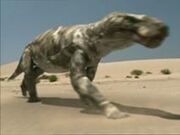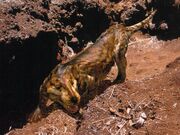Synapsids ('fused arch') are a clade of amniotes that includes mammals and animals closer to mammals than to other living amniotes (reptiles and birds). In classical systematics, the non-mammalian members are described as "mammal-like reptiles", and are sometimes referred to as "proto-mammals" or "stem-mammals". Synapsids are one of the two major groups of amniotes, the other being the sauropsids. They are distinguished from the latter by a single opening (temporal fenestra) in their skull behind each eye, which developed in the ancestral synapsid about 324 MYA during the late Carboniferous period.
The non-mammalian synapsids are traditionally divided into a primitive and an advanced group, known respectively as 'pelycosaurs' and therapsids.
Facts[]
Synapsids (Greek, 'fused arch') are a group of animals that includes mammals and every animal more closely related to mammals than to other living amniotes.
They are easily separated from other amniotes by having a temporal fenestra, an opening low in the skull roof behind each eye, leaving a bony arch beneath each; this accounts for their name.
Primitive synapsids are usually called pelycosaurs; more advanced mammal-like ones, therapsids. The non-mammalian members are described as "mammal-like reptiles" in classical systematics; they can also be called "stem mammals". Synapsids evolved from basal amniotes and are one of the two major groups of the later amniotes; the other is the sauropsids, a group that includes reptiles and birds. The distinctive temporal fenestra developed in the ancestral synapsid about 324 MYA, during the Late Carboniferous period.

Dimetrodon, a pelycosaur.
Synapsids were the largest terrestrial vertebrates in the Permian period, 299 to 251 MYA. As with almost all groups then extant, their numbers and variety were severely reduced by the Permian–Triassic extinction.

A gorgonopsid.
Though some species survived into the Triassic period, archosaurs became the largest and most numerous land vertebrates in the course of this period (Althought some mammals where going after traditional "Dinosaurian niches".). Few of the non-mammalian synapsids outlasted the Triassic, although survivors persisted into the Cretaceous. However, as a phylogenetic unit, they included the mammals, and synapsids are still very much a living group of vertebrates. After the Cretaceous–Paleogene extinction event, the synapsids (in the form of mammals) again became the largest land animals.
The only extant synapsids today are the mammals.

A Thrinaxodon
References[]
See also[]
IberomesornisTemplate:Walking with Beasts Creatures
Template:Walking with Monsters Creatures

A Human
